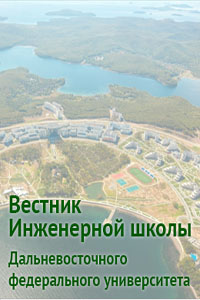Radioactive isotopes in the air of the working area of industrial buildings and structures
DOI:
https://doi.org/10.24866/2227-6858/2024-1/86-95Keywords:
radon, source, radiation, radiation dose, progeny, occupational risks, automationAbstract
Are given the characteristics of the sources of radioactive radon gas, which is invariably present in the working area air. Features of the radon situation formation in working and office premises have been identified and a methodology for predicting radon levels in them has been proposed. Based on the radon balance equation, the possibility of significantly reducing the dose of indoor radon exposure due to the rational organization of air exchange in the room is shown. An approach is proposed to experimentally determine the air exchange rate through simultaneous measurement of radon concentration and equivalent equilibrium radon progeny concentration in the air of the working area.
References
Голованцев С.М. Радон и канцерогенный риск в Москве // Радиационная гигиена. 2015. Т. 8, № 1. С. 16–22. EDN: UHTWPB
Гулабянц Л.А. Моделирование радонового режима здания // Аппаратура и новости радиационных измерений. 2008. № 2(53). С. 52–55.
Гулабянц Л.А., Цапалов А.А. Радонопроницаемость тяжелого бетона // Жилищное строительство. 2011. № 1. С. 39–41. EDN: NQUBUT
Жуковский М.В., Кружалов А.В., Гурвич В.Б., Ярмошенко И.В. Радоновая безопасность зданий. Екатеринбург: Изд-во УрО РАН, 2000. 180 с.
Жуковский М.В., Ярмошенко И.В. Радон: измерение, дозы, оценка риска. Екатеринбург: Изд во УрО РАН, 1997. 232 с.
Калайдо А.В., Римшин В.И., Семенова М.Н., Быков Г.С. Анализ зарубежного опыта обеспечения радоновой безопасности эксплуатируемых зданий (на примере США) // Вестник Вологодского государственного университета. Серия: Технические науки. 2020. Т. 4, № 10. С. 54–58. EDN: WGHUBP
Калайдо А.В., Римшин В.И., Семенова М.Н., Быков Г.С. Пассивные технологии обеспечения радоновой безопасности воздушной среды проектируемых зданий // Вестник Поволжского государственного технологического университета. Серия: Материалы. Конструкции. Технологии. 2021. № 1(17). С. 28–35. https://doi.org/10.25686/2542-114X.2021.1.28
Кормановская Т.А., Ахматдинов Р.Р., Горский Г.А. Итоги 20 лет функционирования Федерального банка данных по дозам природного облучения населения Российской Федерации // Радиационная гигиена. 2021. Т. 14, № 3. С. 112–125. https://doi.org/10.21514/1998-426X-2021-14-3-112-125
Крисюк Э.М. Радиационный фон помещений. Москва: Энергоатомиздат, 1989. 119 с.
Посохин В.Н. О расчете воздухообмена // Сантехника. Отопление. Кондиционирование. 2014. № 4(148). С. 84–88. EDN: TWQWRN
Прозаровская М.А., Панитков О.И. Влияние кратности воздухообмена на эксплуатационные характеристики на примере «Активного дома» // Современные наукоемкие технологии. 2012. № 10. С. 70–73. EDN: PKSXQH
Римшин В.И., Кришан А.Л., Мухаметзянов А.И. Построение диаграммы деформирования одноосно сжатого бетона // Вестник МГСУ. 2015. № 6. С. 23–31. EDN: TYCWVB
Римшин В.И., Калайдо А.В., Семенова М.Н., Давыскиба О.В. Подземные ограждающие конструкции по критериям радоновой безопасности здания // Жилищное строительство. 2023. № 7. С. 40–46. https://doi.org/10.31659/0585-430X-2023-814-6-33-38
Романович И.К., Стамат И.П., Кормановская Т.А., Кононенко Д.В. и др. Природные источники ионизирующего излучения: дозы облучения, радиационные риски, профилактические мероприятия / под ред. Г.Г. Онищенко, А.Ю. Поповой. Санкт-Петербург: ФБУН НИИРГ им. П.В. Рамзаева, 2018. 432 с.
Химическая энциклопедия / под ред. И.Л. Кнунянц и др. Москва: Советская энциклопедия, 1995. Т. 4. ПОЛ–ТРИ. 641 с.
Ярмошенко И.В. Радон как фактор облучения населения России // Биосферная совместимость: человек, регион, технологии. 2017. № 2(18). С. 108–116. EDN: YUDIIL
Darby S., Hill D., Auvinen A. et al. Radon in homes and risk of lung cancer: collaborative analysis of individual data from 13 European case-control studies // British Medical Journal. 2005. № 330. Р. 223–227. https://doi.org/10.1136/bmj.38308.477650.63
Darby S., Hill D., Doil R. Radon: A likely carcinogen at all exposures // Annals of Oncology. 2001. № 12. Р. 1341–1351. URL: https://www.annalsofoncology.org/article/S0923-7534(19)54325-3/pdf (дата обращения: 29.01.2024).
Downloads
Published
Issue
Section
License
Copyright (c) 2024 Far Eastern Federal University: School of Engineering Bulletin

This work is licensed under a Creative Commons Attribution 4.0 International License.

